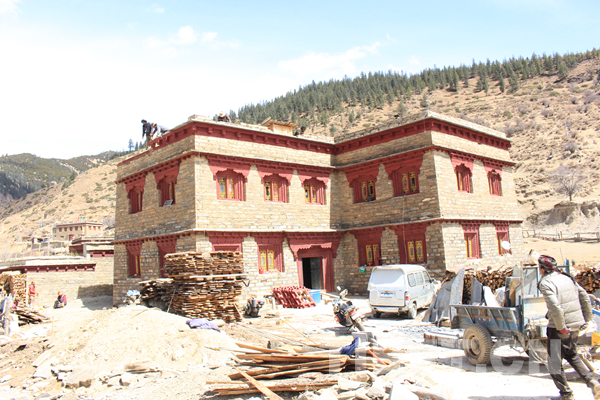A tapestry of achievement: scenery along the 318 (I)
Editor's note: The Sichuan-Tibet Plateau, a beautiful region that reaches toward the heavens, is a place showered with blue skies, covered in white clouds, and dotted with snow-covered mountains, but recently, something truly remarkable has been materializing among the households that call this place home. A groundbreaking historic change has been reshaping the land and its people. From today on, we will publish a series of stories to tell you those changes.
Nyagqu County in Garze Tibetan Autonomous Prefecture is named Yaquke in Tibetan, meaning "mouth of the river". It is located upstream the Nyakchu River and has 35 peaks over 5,000 meters (16,404 feet) above sea level. Jiezhu Village is named "the village of Khampa men", located in Nyagqu County's town of Xi'eluo, and it is one of the birthplaces of the Kham culture, being 60 kilometers (37 miles) from Nyagqu County at an altitude of 3,500 meters (11,483 feet). The village has 863 people from 200 households, among whom 55 people from 14 households live on a basic living allowance, 4 households enjoy the five guarantees (food, clothing, medical care, housing, and funeral expenses), 18 are disabled, and 194 people from 46 households are recognized as impoverished. The main crops include barley, potatoes, and radishes, and people mainly live on farming, with the main sources of income being caterpillar fungus, matsutake mushrooms, and labor as migrant workers.

The new residences to be completed in Jiezhu village.
Happy Life the Pre-Condition to Happy Work
Jiezhu is a poor village that was paired up with Yibin City and targeted for poverty relief in 2017. Since it was paired, Yibin City made it its mission to improve the village's infrastructure and focus on improving its housing and road quality. Tashi Qunpo, the party secretary of Jiezhu Village, still remembers the scene when he first arrived in August 2015. The village was old, shabby, and overgrown with weeds, with garbage and cow dung everywhere. Villagers lived together with the livestock, and specks of dung could splash onto pans and plates at any given moment. Living conditions were extremely poor, and people mainly survived by planting corn and potatoes with a per capita income of less than 1,800 yuan (276.8 USD).
Today, though, Jiezhu has rows of orderly Tibetan residences with dazzling blue-hued stonewalling, red eaves, and windows gleaming under the sunshine. The roads are all blacktopped and installed with streetlights. The village is clean and tidy, with sometimes a yak or two just wandering around. For A Jia's family, who used to live in a 50-square-meter (538-square-foot) house with six people and livestock among them, things have improved considerably. The family has moved into a new house under the recent relocation policy, and their kitchen and toilet have been renovated as part of the "five things rebuilt, three things built" initiative. "The Yibin officials came in and opened our eyes to sanitation," A Jia says excitedly while pouring me some butter tea, "and they helped us build new houses and even better lives!"
The Chinese version of this story is written by Chen Chunlai and translated into English by Huang Wenjuan. And the story is sourced from the United Front Work Deparment of the Communist Party of China (CPC)Sichuan Provincial Committee.
Editor: Ana Wu
Your Comment
Name E-mailRelated News
-
;
Based in Lhasa, Tibet Vista is a Tibet travel agency that specialized in Tibet permit, and Tibet tours for both private and group travelers at a local price!
•4 Days Lhasa City Group Tour from USD 460 •8 Days Everest Base Camp Group Tour from USD 850 •15 Days Mt.Kailash Group Tour from USD 1780 •2016 Tibet Train Tours from Beijing, Shanghai, Chengdu, Xining,etc










